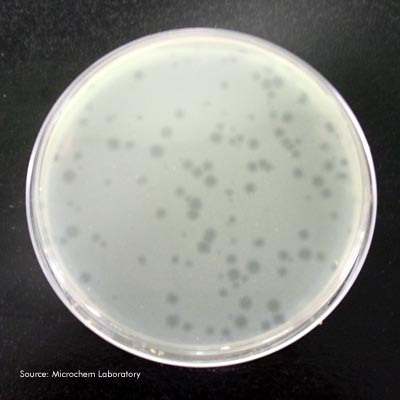Introduction to MS2 Bacteriophage
Many people are familiar with viruses that infect mammalian cells (e.g. Influenza, Poliovirus, or Rhinovirus), but there are also viruses capable of infecting bacterial cells. These viruses are called bacteriophages. Bacteriophages are easy to work with in the context of disinfectant testing and can provide valuable information about product efficacy.
MS2 is a bacteriophage that infects “male” Eschericia coli. Male E. coli are bacterial cells capable of passing a portion of their genetic material (typically in plasmid form) to other bacterial cells through a structure called a pilus. This process of horizontal gene transfer is a vehicle of genetic change within bacterial populations and is particularly well known for spreading antibiotic resistance to previously antibiotic-succeptible bacterial populations.
Morphologically, MS2 is a non-enveloped, icosohedral virus. MS2’s lack of lipid envelope means that it is generally resistant to chemical disinfectants and is also able to withstand environmental stressors like temperature changes, dessication, and osmotic pressure.
MS2 Bacteriophage as a Screening Tool
Cost and Time:
Viral disinfectant efficacy testing has a reputation for slow study turn around times and high costs, largely because of the time and work it takes to propagate viruses and maintain host cell lines. MS2 is an exception to this rule because it requires a bacterial host (which replicates rapidly) instead of mammalian host cells (which replicate slowly). Performing preliminary screens with MS2 can allow you to test a large number of potentially efficacious formulations or evaluate multiple contact times without waiting weeks for results. In addition, the lack of time-intensive cell passages and propagations means that MS2 studies are performed at reduced cost relative to other viruses.
Viral Representative:
The EPA currently recognizes a disinfection hierarchy for viruses, which is generally applied when performing bridging or towelette testing. This hierarchy ranks viruses in the following order:
Small, non-enveloped viruses – most difficult to inactivate
e.g. poliovirus, enterovirus, or rhinovirus
Large, non-enveloped viruses – moderately difficult to inactivate
e.g. adenovirus, rotavirus, or papillomavirus
Enveloped viruses – easy to inactivate
e.g. influenza, herpes virus, or hepatitis virus
MS2 virions are 23-28 nm in diameter, putting them in the category of small non-enveloped viruses like canine parvovirus and human poliovirus. Literature does exist, however, which indicates that MS2 is more sensitive than its counterparts to various methods of disinfection, including UVC light exposure and quaternary ammonium compounds.
In short, MS2 is generally more resistant to inactivation than enveloped viruses but is more sensitive to inactivation than other small non-enveloped viruses. MS2’s documented moderate sensitivity makes it easy to use data gathered from MS2 testing to gauge the efficacy of a product before starting larger, more complex mammalian virus studies. The use of MS2 bacteriophage specifically as a viral representative is also recognized by EPA. On the basis of its morphological characteristics, the EPA considers MS2 to be an adequate viral representative for water filtration and purification testing.
References
- Calgua, B., et al. “UVC Inactivation of dsDNA and ssRNA Viruses in Water: UV Fluences and a qPCR-Based Approach to Evaluate Decay on Viral Infectivity.” Food and Environmental Virology 6.4 (2014): 260-268.
- D’Souza, D. H. and Su, X. “Efficacy of Chemical Treatments Against Murine Norovirus, Feline Calicivirus, and MS2 Bacteriophage.” Foodborne Pathogens and Disease 7.3 (2010): 319-326.
- Kuzmanovic, D. A., et al. “Bacteriophage MS2: Molecular Weight and Spatial Distribution of the Protein and RNA Components by Small-Angle Neutron Scattering and Virus Counting.” Structure 11.11 (2003): 1339-1348.

